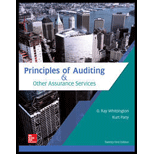
Principles Of Auditing & Other Assurance Services
21st Edition
ISBN: 9781259916984
Author: WHITTINGTON, Ray, Pany, Kurt
Publisher: Mcgraw-hill Education,
expand_more
expand_more
format_list_bulleted
Question
Chapter 15, Problem 19RQ
To determine
Explain the source of information regarding a year-end list of stockholders when the services of the independent stock registrar or transfer agent are not used.
Expert Solution & Answer
Want to see the full answer?
Check out a sample textbook solution
Students have asked these similar questions
What is this firm's debt-equalty ratio ?
General accounting
I need help with question is correct answer and accounting
Chapter 15 Solutions
Principles Of Auditing & Other Assurance Services
Ch. 15 - What does the trust indenture used by a...Ch. 15 - Long-term creditors often insist upon placing...Ch. 15 - Prob. 3RQCh. 15 - Prob. 4RQCh. 15 - Prob. 5RQCh. 15 - Prob. 6RQCh. 15 - Prob. 7RQCh. 15 - Prob. 8RQCh. 15 - Prob. 9RQCh. 15 - Prob. 10RQ
Ch. 15 - Mansfield Corporation has outstanding an issue of...Ch. 15 - Prob. 12RQCh. 15 - Prob. 13RQCh. 15 - What do you consider to be the most important...Ch. 15 - What is the primary responsibility of an...Ch. 15 - In the audit of a small corporation that issues...Ch. 15 - Prob. 17RQCh. 15 - Prob. 18RQCh. 15 - Prob. 19RQCh. 15 - Corporations sometimes issue their own capital...Ch. 15 - Prob. 21RQCh. 15 - Prob. 22RQCh. 15 - Prob. 23RQCh. 15 - Prob. 24RQCh. 15 - Prob. 25RQCh. 15 - Prob. 26RQCh. 15 - Prob. 27QRACh. 15 - Prob. 28QRACh. 15 - Prob. 29QRACh. 15 - You are retained by Columbia Corporation to audit...Ch. 15 - Prob. 31QRACh. 15 - Prob. 32AOQCh. 15 - Prob. 32BOQCh. 15 - Prob. 32COQCh. 15 - Prob. 32DOQCh. 15 - Prob. 32EOQCh. 15 - When a client uses paper stock certificates, an...Ch. 15 - Prob. 32GOQCh. 15 - The auditors can best verify a clients bond...Ch. 15 - Prob. 32IOQCh. 15 - All corporate capital stock transactions should...Ch. 15 - Prob. 32KOQCh. 15 - Prob. 32LOQCh. 15 - Prob. 32MOQCh. 15 - Prob. 32NOQCh. 15 - Prob. 32OOQCh. 15 - An auditor most likely would inspect loan...Ch. 15 - Prob. 32QOQCh. 15 - Match the following definitions (or partial...Ch. 15 - Prob. 34PCh. 15 - Prob. 35PCh. 15 - Prob. 36PCh. 15 - Prob. 37P
Knowledge Booster
Similar questions
- Help with accounting questionarrow_forwardPlease help me solve this general accounting question using the right accounting principles.arrow_forwardNevaeh Manufacturing company has a beginning finished goods inventory of $16,200, cost of goods manufactured of $45,800, and an ending finished goods inventory of $18,500. The cost of goods sold for this company is: A. $37,300 B. $45,100 C. $43,500 D. $47,500 Zenith Enterprises has sales of $350,000, cost of goods sold of $190,000, net profit of $15,600, net fixed assets of $170,000, and current assets of $95,000. What is the total asset turnover rate?arrow_forward
arrow_back_ios
SEE MORE QUESTIONS
arrow_forward_ios
Recommended textbooks for you
 Auditing: A Risk Based-Approach (MindTap Course L...AccountingISBN:9781337619455Author:Karla M Johnstone, Audrey A. Gramling, Larry E. RittenbergPublisher:Cengage LearningPrinciples of Accounting Volume 1AccountingISBN:9781947172685Author:OpenStaxPublisher:OpenStax College
Auditing: A Risk Based-Approach (MindTap Course L...AccountingISBN:9781337619455Author:Karla M Johnstone, Audrey A. Gramling, Larry E. RittenbergPublisher:Cengage LearningPrinciples of Accounting Volume 1AccountingISBN:9781947172685Author:OpenStaxPublisher:OpenStax College

Auditing: A Risk Based-Approach (MindTap Course L...
Accounting
ISBN:9781337619455
Author:Karla M Johnstone, Audrey A. Gramling, Larry E. Rittenberg
Publisher:Cengage Learning

Principles of Accounting Volume 1
Accounting
ISBN:9781947172685
Author:OpenStax
Publisher:OpenStax College
